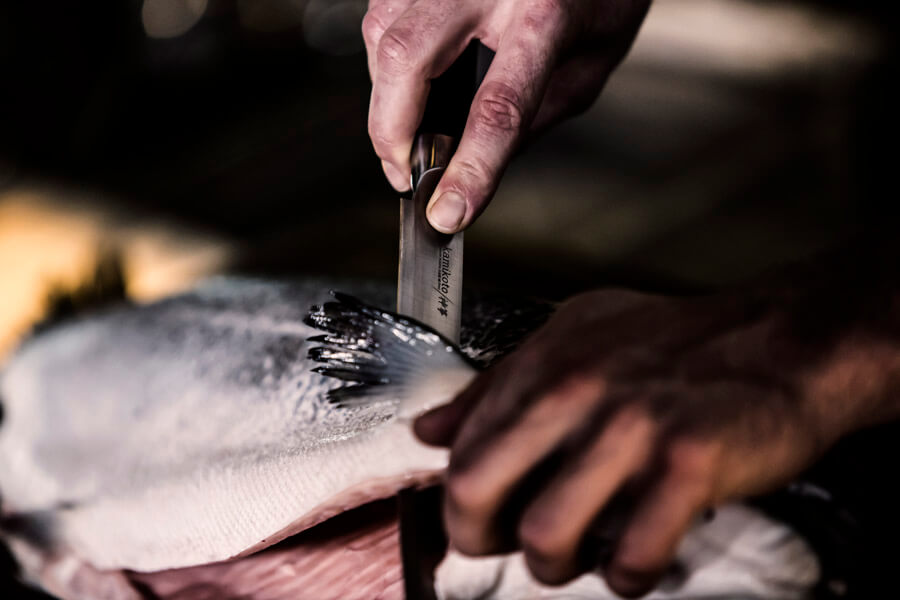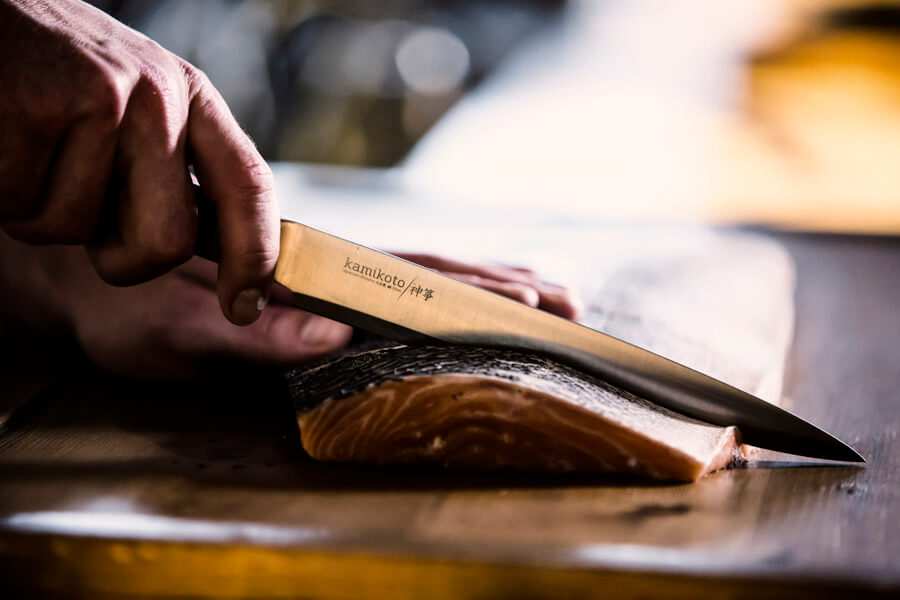
There is an art to fish preparation and it is nowhere more evident than when watching a masterful Japanese chef prepare intricate sushi dishes. Using their fine knife skills to scale, gut, clean and slice fish, it is difficult not to be amazed by their precision and talent. Most chefs work hard to understand the art and technique inherent in the process of fish preparation, determined to also acquire this same aptitude.
Understanding How Fish Differs from Meat
Before beginning the process of fish preparation, one must first understand the difference between fish flesh and meat. This primarily has to do with their muscle make-up.
Meat muscles and connective tissues are generally quite firm and sinewy and as such, benefit from either slow cooking methods or ones that required a high level of flame. But in fish, muscle and connective tissues are far more delicate. The cooking method must be adjusted for this, treating the protein with care so as not to damage the fine fish flesh.
Another consideration for chefs in fish preparation is to determine which category of flesh the particular fish falls into.
There are three broad categories:
- Delicate
- Medium
- Firm
Technique When Scaling a Fish
Scaling a fish is a fairly straight forward process, however it can be messy to perform. Before beginning, it is wise to gather and set out all equipment needed, as well as protect the cleaning area from flying fish scales.
Recommended Fish Scaling Equipment
- Specialty fish scaler (a butter knife can also be used if preferred)
- Clean garbage bag if working indoors (this can be handy to help catch flying scales)
- Newspaper
- Large cutting board
- Faucet
- Gloves (optional)
Scaling Steps
- Lay out a large section of newspaper underneath cutting board
- If using a bag, spread it wide open on top of cutting board & place fish flat inside bag
- Hold fish tail
- Using the scaler (or butter knife) run it up and down the fish body, using small back and forward motions. This should lift all the scales off
- Repeat on the other side
- Wash fish thoroughly on both sides
Technique When Gutting and Cleaning a Fish

Gutting and cleaning a fish is an essential step in the preparation process as all fish innards must be removed before cooking to ensure diners’ safety.
The gutting technique differs very slightly as there are many fish shape variations. However, the broad steps of making a large slit, removing the innards and cleaning, are the same no matter the fish size or shape.
Before beginning the process, set up the required equipment.
Recommended Fish Gutting and Cleaning Equipment
- Newspaper
- Large cutting board
- Faucet
- Gloves (optional)
- Bucket
- Fish filleting knife
Gutting & Cleaning Steps
- Lay newspaper down on the bench
- Place cutting board on top
- Lay fish down on board
- Insert tip of fish knife into the belly near anal opening/vent/tail end
- Run the knife up and along the belly, slitting it open, finishing the cut at the head
- Ensure this cut is very shallow, using only the knife tip so as not to pierce the innards
- Spread the body open
- Pull all innards out
- Discard in bucket
- If the fish has a bloodline, scrap this out with thumbnail or knife, being careful not to pierce flesh
- Slice off all fins and discard in bucket
- Rinse the cavity out under running water
Differences in Preparing Varieties of Fish
Most fish species can be scaled, gutted and cleaned following the procedures outlined above. However, what follows are some extra guidelines with relation to some of the most commonly used fish.
How to Clean Mackerel
This is an immensely popular fish variety in many countries. Mackerel are an oily fish that lend well to smoking, salting, grilling and stewing. It has a medium to firm texture.
Even though mackerel have very small scales, they do not need to be scaled. However, a thorough wash of the skin is recommended.
As for gutting and cleaning, follow the same technique as outlined above. Pay extra attention to scooping out the bloodline as mackerel have pronounced ones.
How to Clean Trout

Trout are freshwater fish and are somewhat similar in shape to salmon. They are also oily and rich in omega-3 fatty acids. There are numerous varieties and their flesh is pink in color, with a medium to firm texture.
In terms of preparing, first begin by scaling. Some smaller trout species may not require this step as their scales are tiny. However, to ensure a professional dish finish, scaling is recommended.
While one can employ the gutting and cleaning method detailed earlier, there is another technique to attempt. Use the following method if it is not important to keep the fish head intact in the final outcome of the dish, ie when using fillets.
Alternative Gutting and Cleaning Technique for Trout
- Prepare the cleaning area appropriately (gather all equipment and protect surfaces)
- Lay fish down on cutting board
- Locate the anal opening/vent
- Insert tip of fish knife into this vent and slit all the way to the head
- Ensure this cut is very shallow, using only the knife tip, so as not to pierce the innards
- Make another cut behind the head through the backbone but not all the way through
- Grip the head and pull it straight down towards the tail. The fins and all the innards should come out in one whole piece
- Discard innards bucket
- Open up fish and scrap out bloodline with thumbnail or knife, being careful not to pierce flesh
- Rinse the cavity thoroughly under running water
How to Clean Salmon

Salmon is a unique species of fish that is born in freshwater, lives in seawater but migrates back to fresh to spawn. They have a beautiful deep pink to red flesh color depending on the variety. With a very fatty texture, they lend themselves to being eaten raw, lightly seared, grilled or smoked.
The same scaling, cleaning and gutting technique for a trout can be used.
How to Clean Swordfish

Swordfish are a very large species of fish featuring a long, sharp, sword-like bill. They are an oily fish with a very firm flesh, thus can handle more robust cooking methods.
As swordfish commonly reach 3 metres or up to 10 feet in size, gutting and cleaning is quite labor-intensive and requires dexterity and strength.
Adult swordfish do not have scales so there is no need to scale them, however a full and through wash down of the body is recommended.
Gutting and Cleaning Technique
- Prepare a very large cleaning area (gather all equipment and protect surfaces)
- Lay fish down on one side and cut off the bill, tail, all fins and head
- Make a shallow incision in the belly from the head towards the end of the fish
- Pull out all innards and discard
- Cut down both sides of the spine
- Pull out the bloodline and slice off
- Thoroughly scrub and wash out the cavity, paying particular attention to where the bloodline was situated
How to Clean Shark
There are multiple species of shark consumed all over the world. Gummy shark, sand shark and makos are just a few. Most shark have a very firm texture so they can handle hardier cooking methods.
As shark vary in size quite dramatically, larger specialty filleting knives may need to be used when preparing them. Always ensure the right knife is selected for the particular job to minimize the risk of accidents.
When it comes to scaling, gutting and cleaning, the same method can be used as that for swordfish. However, shark fillets will also need to be skinned.
Learning how to scale, gut and clean a fish properly is an important skill to add to a culinary toolkit. Due to the infinite vary of fish available, it is something one can practice and hone over time to develop into a true masterchef.


